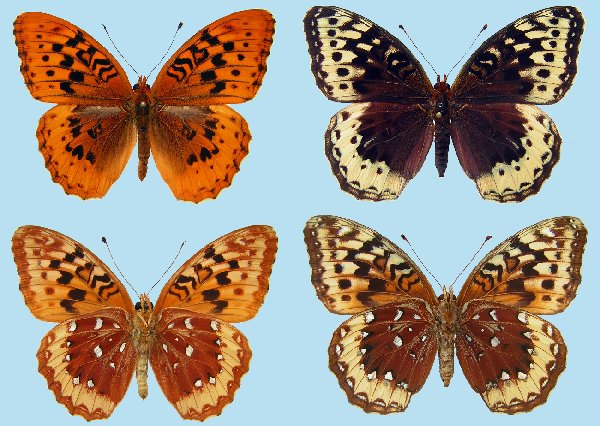Speyeria cybele letona

Photo Life History: Speyeria cybele letona
Habitat: Mountain Canyons; Valley Wet Meadows; Wetlands
Host Plants: Viola nephrophylla; Viola nuttallii
Suitable Lab Host Plants: Viola tricolor (Most any spp. of Viola will work in the lab. Avoid species where leaves are pubescent.)
How to Find Female Butterflies: Check habitat--pay particular attention to thistles--roughly three to four weeks after males were seen in mid-flight. Click here.
Caring for Live Female Butterflies: Nectaring techniques. By feeding females regularly, they can remain alive for weeks and can produce several hundred ova in the lab.
Methods of Female Oviposition: Open Screen Cages; Brown Bag. (Females lay eggs haphazardly in proximity to live or dead host leaves.) THE most productive way to rear any Speyeria is to obtain eggs from females.
How to Find Eggs: Not productive. Females lay eggs haphazardly on the ground near living or dried up host plant.
How to Hatch Eggs: Consolidate eggs into one container. (Eggs are yellow turning orange and then brownish before hatching. Eggs that remain yellowish are infertile. Eggs usually take roughly 14-20 days to hatch in the lab.)
How to Find Caterpillars in the Field: Not generally productive as larvae feed mainly at night and rest away from host leaves. (However, on two separate occasions, I have been fortunate enough to notice a fast-paced, wandering S. cybele letona sixth instar caterpillar in the wild. If that happens, set it up to pupate. It is done feeding.)
How to Find Pupae in the Field:
Caterpillar setups: For all Speyeria, I recommend different setups depending upon the instar of the larva. Also, strategies and setups have to with whether you overwinter unfed first instars and allow them to start feeding in the spring or force them to start feeding in the fall. Both strategies have advantages and disadvantages and can be somewhat difficult.
Forcing Larvae to Initiate Feeding in the Fall: Watch this video. Also, see Avoiding Diapause Techniques section.
First and Second Instars: For small larvae, I recommend the twin cup method. (However, be sure to account for the fact that pansy and violet stems are convex in shape creating a gap where larvae wandering off the leaf to conceal themselves have been known to crawl down the stem through this opening and into the water where they drown. Placing multiple stalks through the hole tends resolve this problem. Also, Nicky Davis created a work around by fitting a tooth pick flush into the stem of the violet. Replace frass and host every three to four days. (Do not overcrowd larvae as they can easily become sick if overexposed to frass, too much humidity, or both.)
Third through Sixth Instars: If rearing Speyeria in the fall, I recommend the potted plant technique. Pansies are usually available in nurseries and can be repotted so that they fit either a cage extension or with a paint strainer. (See examples of both in the potted plant technique section.) If rearing Speyeria in the spring, and you have access to a good supply of violets, I recommend the open terrarium with base technique. (See this ad-hoc video for thoughts on setting it up.)
Larva to Pupa: Caterpillar silks to leaf or twig; creates and attaches cremaster; hanging as a J before pupating.
Number of Broods per Year: 1
Overwintering Stage: Unfed first instar larva
Overwintering Strategies: Click on the link to the right and follow these steps carefully: Refrigerator--Unfed First Instars
Post-Hibernation Strategies: Provide larvae with warmer temperatures, and healthy host plant; Set up using the twin cup method and follow the exact same steps as outlined under Caterpillar Setups: First and Second Instars.
Avoiding Diapause Techniques: Watch this video first. Place violet or pansy cuttings into a floral aquapic, aquatube or similar. Make sure that you have enough cuttings in the aquapic so that water does not escape through the lid when you place it horizontal side down in a closed container. Place unfed first instar larvae on pansy cuttings while placing the aquapic in a closed container. Expose closed container to a light source that is close enough to create at least 95 degrees of heat 24 hours a day. Unfed first instars will want to naturally crawl under a leaf and re-diapause. Stir up larvae 2-3 times a day to try to entice them to start feeding. Repeat (can be a royal pain in the ...) until larvae initiate feeding. (This usually takes only 1 day for Speyeria nokomis ssp.; 3-4 days for Speyeria cybele spp, Speyeria idalia, and Speyeria diana; longer for smaller species of Speyeria).
Disease Prevention: This is absolutely critical for rearing any Speyeria species. Young larvae that are over-exposed to their own frass or to too much humidity using the twin cup technique can become sick and die. Other healthy larvae can also become sick if larvae are crowded. Try to keep your rearing environment as dry as possible with dedicated effort to remove frass and old plant every 3-4 days.
Emergence: Emergence Container
Field Notes: Successfully rearing Speyeria species requires a lot of time, effort, and patience. One of the biggest hurdles involves the amount of time required to rear these butterflies in numbers. Part of the problem is that a single female can lay up to 500 ova in the lab. When inexperienced lepidopterists try to rear too many Speyeria spp. caterpillars at one time, larvae are not usually properly taken care of resulting in disease that can wipe out all caterpillars. It's important to get your arms around how many larvae you can take care of before committing to any given number. Just because a female lays 800 eggs, doesn't mean that your obligated to try and rear all of them. Find some friends who might want to rear this butterfly or place eggs back in the habitat near violets where you collected the live female.

